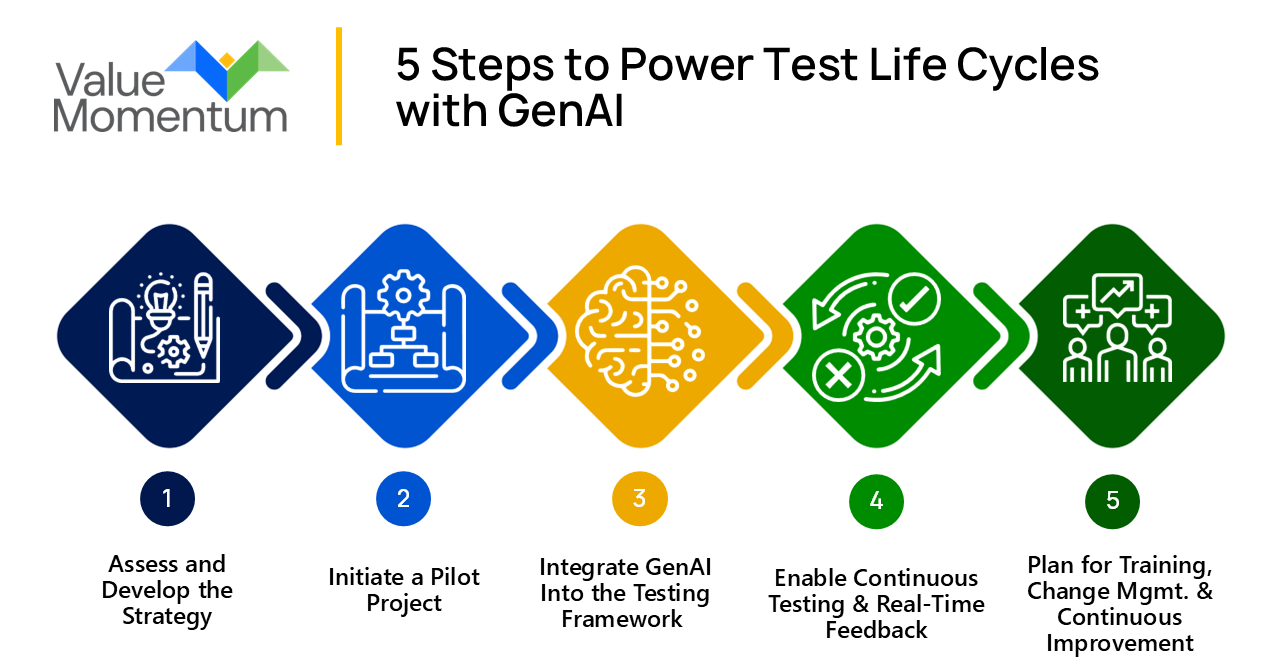Traditional testing methods often struggle to keep pace with insurers as their business scales, leading to inefficiencies, elevated costs, and an increased risk of defects slipping through. Artificial intelligence (AI) presents the insurance industry with a major opportunity to enhance their testing life cycle and drive efficiency.
Yet, according to a recent survey, 60% of respondents working in testing are yet to embrace AI in their processes. Delays in adopting and adapting new testing methods can result in missed opportunities and a loss of competitive advantage.
By integrating generative AI (GenAI) technologies into the testing life cycle, insurers can automate and optimize at every stage — test case creation, data generation, execution, and validation — to keep insurers’ business running smoothly.
GenAI-Driven Enhancements to the Software Testing Life Cycle
The software testing life cycle is a cornerstone of successful product development, especially in the insurance industry, where complex systems and high-stakes operations leave little room for error. GenAI can bring a transformative approach to testing, addressing operational inefficiencies, reducing costs, and enhancing overall quality.
Here are five ways GenAI is reshaping testing for the better:
- Improved test coverage: GenAI addresses blind spots that traditional manual methods might overlook, which serves as a stronger safeguard against critical defects, helps identify issues earlier in the development cycle, and reduces resolution costs.
- Optimized efficiency: GenAI streamlines traditional testing workflows by automating and prioritizing test execution, as well as features self-healing automation scripts that dynamically adjust to system updates.
- Reduced dependency on QA teams: GenAI reduces bottlenecks in traditional workflows by automating routine tasks like test design, data generation, and validation, allowing QA teams to focus on strategic initiatives like refining processes and improving product quality.
- Increased automation: Extending automation to include broader processes like test execution, data creation, and result validation ensures comprehensive coverage, whichreduces reliance on manual QA efforts and accelerates testing cycles.
- Faster feedback and better code quality: Automated validation for code changes ensures issues are identified and addressed early, improves overall code quality, enables quicker iterations, and provides real-time insights into impacted areas of the code.
To fully realize these benefits, insurers need a clear strategy for integrating GenAI into their testing processes — starting with understanding their unique requirements and identifying key areas for automation.
5 Steps to Power Test Life Cycle Automation With GenAI
The journey toward integrating GenAI into the software testing life cycle requires careful planning and execution. While the benefits of GenAI are clear, achieving these outcomes hinges on a strategic approach tailored to an insurer’s unique needs and systems.
By following these steps, insurers can harness the full potential of GenAI, streamlining testing processes and delivering high-quality software at speed and scale:

1. Assess and Develop the Strategy
The first step in implementing GenAI-powered test life cycle automation is to conduct a comprehensive assessment of your current software testing life cycle. Identify existing bottlenecks, inefficiencies, and areas where GenAI can deliver the most significant improvements. For example, manual test case creation is highly dependent on the knowledge of individual teams. However, with GenAI-fueled automation, these test cases can be standardized, reducing the potential for error. Understanding these challenges provides a foundation for targeted, impactful automation efforts.
Develop a strategic roadmap for integrating GenAI into testing processes by using the assessment outcomes. This roadmap should align with the organization’s key objectives — whether it’s improving efficiency, reducing costs, or enhancing test coverage — and define clear milestones for implementation.
2. Initiate a Pilot Project
With the strategy in place, launch a pilot to test GenAI automation on a smaller scale. Select a few critical projects across different components of the insurance life cycle, such as claim processing or policy management, where GenAI can have an immediate and measurable impact. Focusing on a diverse set of use cases allows teams to evaluate GenAI’s effectiveness while identifying potential hurdles in critical processes.
To ensure the success of the pilot, establish clear key performance indicators (KPIs) such as test coverage, test cycle time, and defect leakage rates. For example, tracking automated test case execution time compared to manual processes can provide concrete evidence of time savings. By evaluating similar metrics against predefined benchmarks, insurers can refine their approach and confidently scale GenAI automation across broader testing efforts.
3. Integrate GenAI Into the Testing Framework
After a successful pilot, integrate GenAI into the broader testing framework, starting with automated test case generation. GenAI can analyze requirements, user stories, and process flows to create comprehensive and precise test cases. This automation not only reduces manual effort but also increases consistency and alleviates ambiguity, allowing QA teams to focus on higher-value activities like optimizing test strategies and addressing complex edge cases.
GenAI can also generate synthetic test data that aligns with insurers’ testing needs while ensuring compliance with data privacy regulations. For example, it can simulate customer data for policy creation or claims processing scenarios without exposing sensitive information. This capability enhances the robustness and accuracy of tests, enabling insurers to validate system performance effectively across various conditions.
4. Enable Continuous Testing and Real-Time Feedback
Integrating GenAI with continuous integration and continuous delivery (CI/CD) pipelines is a key step in enabling real-time testing and feedback. With this integration, every code change automatically triggers GenAI-driven tests, ensuring issues are identified and addressed promptly. It can pinpoint impacted code and establish both backward and forward traceability, allowing development teams to focus their efforts on areas most likely to require attention.
Additionally, GenAI automates test case execution and generates intelligent reports that provide actionable insights for teams to continuously refine their processes. By embedding this automated execution and feedback loop into the development cycle, insurers can achieve faster releases, maintain high-quality standards, and adapt quickly to evolving business and customer demands.
5. Plan for Training, Change Management, and Continuous Improvement
Implementing GenAI-powered automation requires not only new tools but also a shift in mindset and processes. Provide comprehensive training sessions for QA teams to familiarize them with GenAI tools and automation best practices. These sessions should cover how to use the tools effectively, interpret test results, and apply insights to optimize testing strategies.
Engaging stakeholders early and incorporating their feedback into the transition plan can help build trust and encourage buy-in.
To maximize the long-term value of GenAI-powered test automation, insurers should establish a process for continuous improvement. Analyze metrics, user experiences, and test outcomes from pilot projects and early implementations to identify where performance can be refined. With a proven framework in place, gradually expand the implementation to all lines of business and applications, tailoring the approach to meet specific requirements for different systems or teams.
Successful implementation of GenAI-powered automation doesn’t end with deployment — it requires ongoing monitoring and refinement to maintain and enhance performance. Amend the framework as needed so it continues to deliver value as testing demands grow and evolve.
Empowering the Future of Software Testing With GenAI
GenAI is more than just a technological innovation; it is a strategic enabler for insurers aiming to modernize their software testing life cycle. By reducing reliance on manual processes and automating complex, resource-intensive tasks, GenAI empowers teams to deliver faster, more reliable results while reallocating resources toward innovation and growth.
Insurers that embrace this technology gain a competitive edge by accelerating their time to market, reducing costs, and improving the quality of their offerings.
Learn more about how to accelerate your organization’s software testing life cycle. Check out our case study Large Specialty Insurer Drives UX & Speed to Market With QE Test Automation to find out how one insurer drove business results by improving its test automation.




